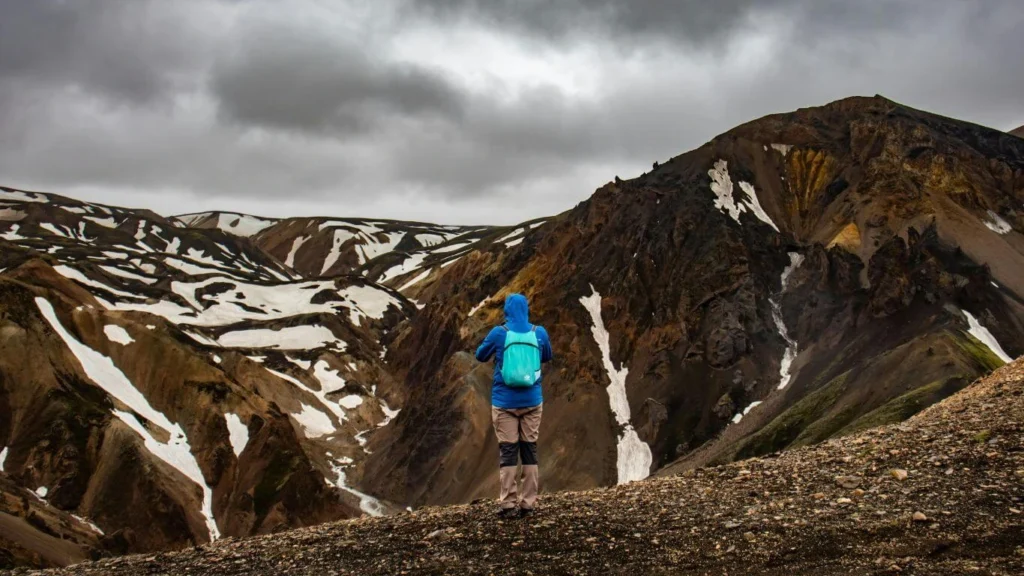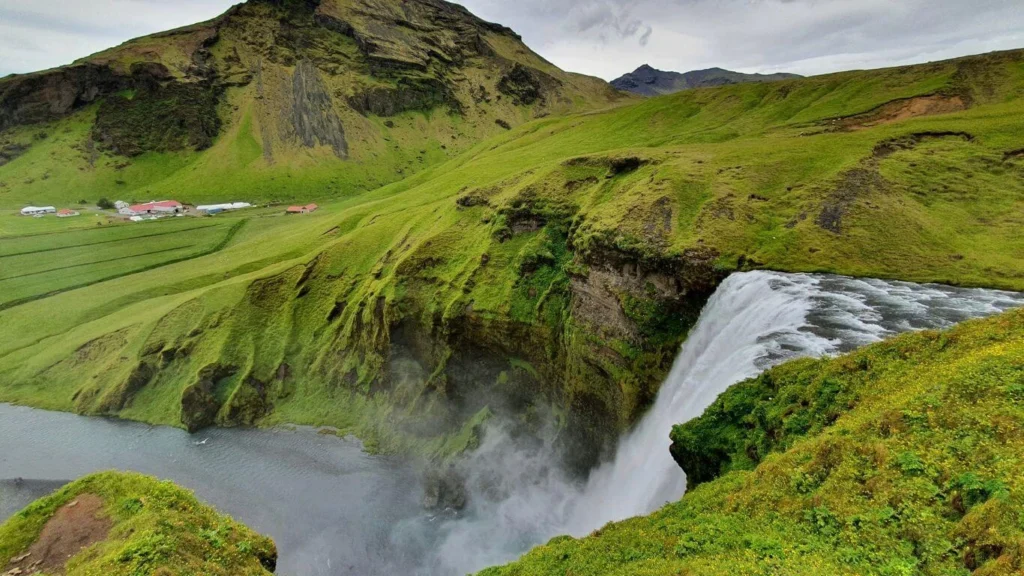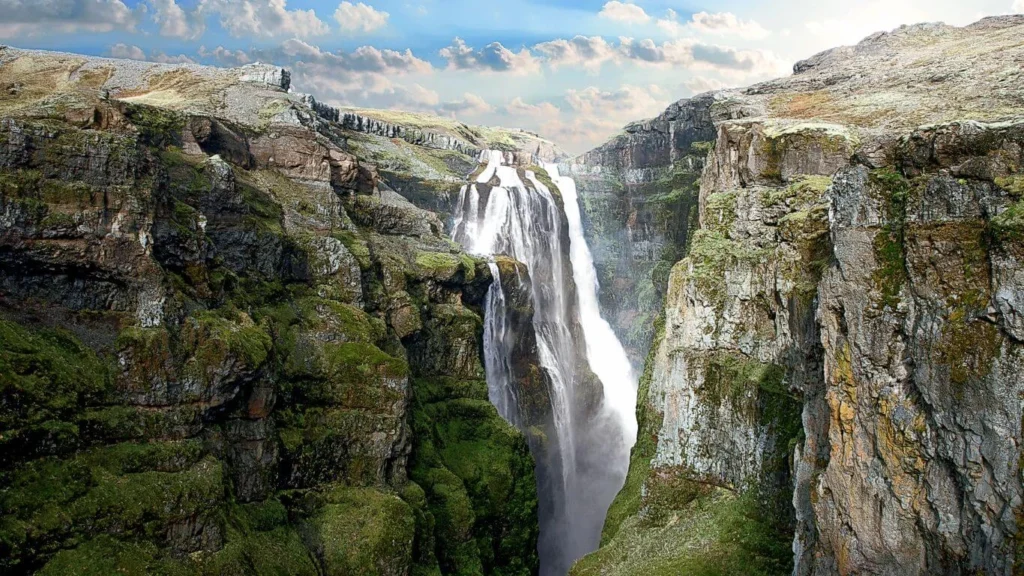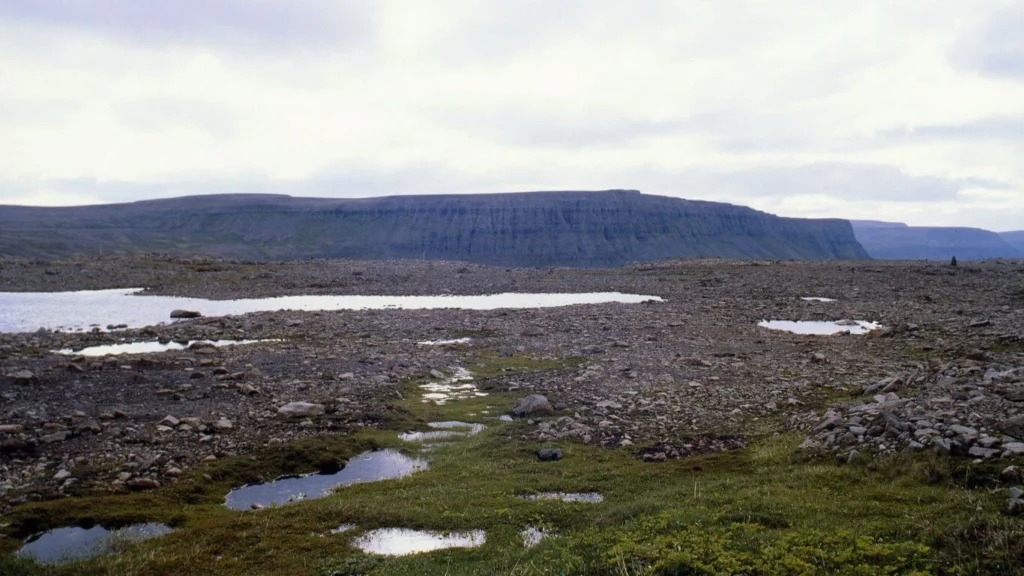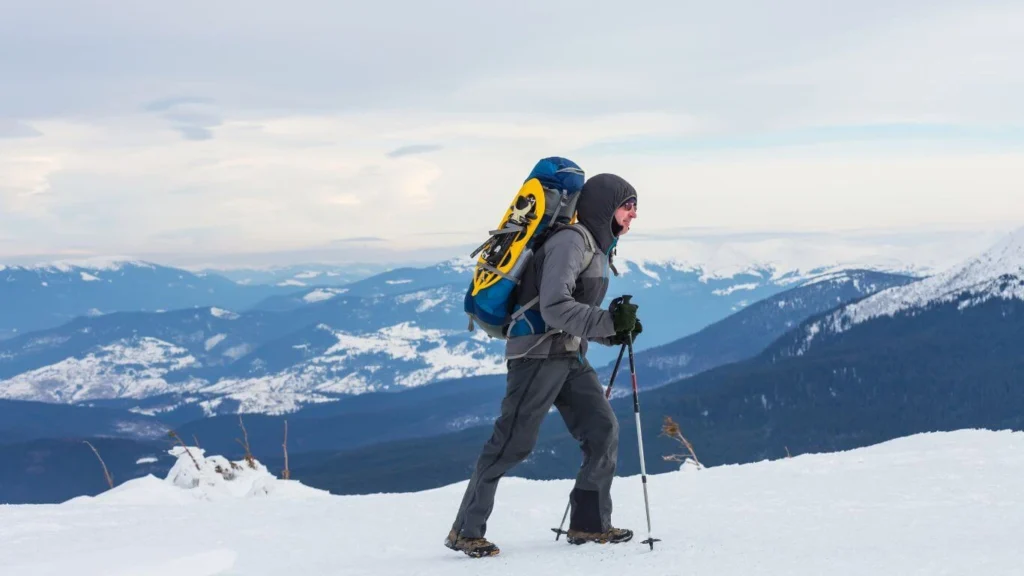Iceland is a hiker’s paradise, offering some of the most breathtaking hiking trails in the world. Whether you’re looking for a multi-day adventure through lava fields and glaciers or a short scenic hike to a waterfall, Iceland’s hiking trails deliver unforgettable landscapes.
From the iconic Laugavegur Trail, winding through volcanic valleys, to the challenging Fimmvörðuháls trek between two active volcanoes, there’s a route for every skill level. For those seeking remote wilderness, the Hornstrandir Nature Reserve offers pure isolation with no roads—just raw Icelandic beauty.
If you’re planning a hiking trip to Iceland, this guide covers the best hiking trails in Iceland, with essential tips, safety advice, and the best times to visit. Get ready to explore Iceland on foot!
1. Laugavegur Trail: A Multi-Day Iceland Trek Through Volcanic Landscapes
The Laugavegur Trail is Iceland’s most famous long-distance hiking route, covering 55 km from Landmannalaugar to Þórsmörk. It typically takes 4-5 days, depending on weather conditions and hiking speed.
What Makes This Hike Special?
- Diverse Landscapes: Traverse lava fields, geothermal hot springs, glaciers, and volcanic deserts all in one hike.
- Mountain Huts & Camping: Stay in remote huts or camp under the midnight sun.
- River Crossings: Some parts of the trail require wading through glacial rivers—proper footwear is essential.
📌 Best Time to Hike: June to September (when trails are snow-free and huts are open).
📌 Pro Tip: Book mountain hut accommodations in advance as they fill up quickly during peak season.
Hot Springs, Lava Fields, and Glaciers
Hiking in Iceland is unlike anywhere else in the world—you’ll encounter steaming hot springs, vast lava fields, and icy glaciers, often within the same trek.
- Hot Springs: The Landmannalaugar area, at the start of the Laugavegur Trail, is famous for geothermal pools perfect for a soak.
- Lava Fields: Walk across solidified lava from past eruptions, with deep black and red hues covering the terrain.
- Glaciers: The Eyjafjallajökull and Mýrdalsjökull glaciers can be seen from many trails, adding breathtaking views to the journey.
📌 Pro Tip: Bring a swimsuit to enjoy the hot springs in Landmannalaugar before starting your trek.
Planning to hike the legendary Laugavegur Trail? Get the official route map, weather updates, and essential hiking tips straight from Visit Iceland’s tourism board. Ensure you’re well-prepared for this breathtaking 55 km trek through lava fields, hot springs, and glaciers.
👉 Check the official Laugavegur Trail guide here.
Best Time: June to September
The best months for hiking in Iceland are June to September when the trails are free of snow, river crossings are manageable, and daylight lasts longer.
- June: 24-hour daylight due to the Midnight Sun, making it ideal for long hikes.
- July & August: Peak hiking season with mild temperatures (10-15°C) and open huts.
- September: Fewer crowds and beautiful autumn colors across the landscapes.
📌 Pro Tip: Always check weather forecasts before setting out—conditions can change rapidly even in summer.
2. Fimmvörðuháls Trail (Challenging, 1-2 days)
The Fimmvörðuháls Trail is a challenging 25 km hike, connecting the majestic Skógafoss waterfall with Þórsmörk Valley.
Why Is This Hike Famous?
- Starts at Skógafoss, one of Iceland’s most iconic waterfalls.
- Passes 26 smaller waterfalls along the Skógá River.
- Crosses lava fields from the 2010 Eyjafjallajökull eruption.
- Ends in the lush Þórsmörk Valley, surrounded by mountains and glaciers.
📌 Best Time to Hike: July to early September (to avoid snow and river flooding).
📌 Pro Tip: Strong winds and cold temperatures are common at higher elevations—pack warm layers.
Before setting off on the Fimmvörðuháls Trail, check real-time weather conditions, trail closures, and road access to Skógafoss and Þórsmörk. Stay ahead of volcanic activity and ensure a safe and memorable hike.
👉 Get the latest trail updates here.
Two Active Volcanoes and Breathtaking Views
The Fimmvörðuháls Trail runs between two active volcanoes—Eyjafjallajökull and Katla—providing some of Iceland’s most dramatic landscapes.
- Eyjafjallajökull: Famous for its 2010 eruption, this volcano left behind fresh lava fields and steaming vents.
- Katla: One of Iceland’s most powerful and unpredictable volcanoes, covered by Mýrdalsjökull Glacier.
📌 Pro Tip: Hikers often see steam rising from the lava fields, showing that Iceland’s landscapes are still evolving.
3. Glymur Waterfall Hike (Easy, Half-day)
Glymur Waterfall is 198 meters high, making it one of the tallest waterfalls in Iceland. This moderate 7 km hike is perfect for those looking for a half-day adventure.
Highlights of the Hike:
- Cross a river via a log bridge for an extra thrill.
- Explore a small cave along the trail.
- Enjoy panoramic views of the waterfall and surrounding fjord.
📌 Best Time to Hike: May to October (before winter ice makes trails slippery).
📌 Pro Tip: Wear waterproof hiking boots—the river crossings can be wet and slippery.
Looking for a detailed route map for the Glymur Waterfall Hike? See trail difficulty, traveler reviews, and GPS navigation on AllTrails. This half-day trek is perfect for those seeking river crossings, cave exploration, and panoramic waterfall views.
👉 Explore the Glymur trail map here.
River Crossings and Cave Exploration
Hiking in Iceland often involves crossing rivers and exploring natural caves, adding an adventurous element to many trails.
- Laugavegur & Fimmvörðuháls: Require wading through glacial rivers, which can be waist-deep in early summer.
- Glymur Hike: Features a cave tunnel near the waterfall, offering a unique perspective.
📌 Pro Tip: Bring sandals or waterproof socks for river crossings to keep hiking boots dry.
4. Hornstrandir Nature Reserve (Remote, Multi-day)
The Hornstrandir Nature Reserve in the Westfjords is one of the most remote hiking destinations in Iceland.
Why Is This Hike Unique?
- No roads, no towns, no human settlements—just pure wilderness.
- Steep cliffs, Arctic tundra, and coastal fjords.
- Only accessible by boat, making it one of the least-visited places in Iceland.
📌 Best Time to Hike: July to mid-August (before weather conditions become too harsh).
📌 Pro Tip: Pack all food and camping gear—there are no stores or services in the area.
Venturing into Hornstrandir Nature Reserve? Discover everything about this remote, untouched wilderness, including boat schedules, camping permits, and wildlife spotting tips. Experience Iceland’s Arctic foxes, rugged fjords, and midnight sun.
👉 Plan your Hornstrandir trip here.
Arctic Foxes and Midnight Sun Views
Hornstrandir is one of the best places in Iceland to see Arctic foxes, as they are completely protected from hunting in this region.
- Midnight Sun: In summer, there is no darkness, allowing hikers to explore 24/7.
- Birdwatching Paradise: Home to puffins, guillemots, and arctic terns.
📌 Pro Tip: Arctic foxes are not afraid of humans—if you camp overnight, you might see them playing near your tent.
5. Essential Tips for Hiking in Iceland
Iceland’s landscapes are stunning but unpredictable. Whether you’re hiking for a few hours or multiple days, preparation is key.
✅ Dress for Unpredictable Weather
- Layer up with moisture-wicking and waterproof gear.
- Even in summer, temperatures can drop to freezing.
✅ Carry GPS and Emergency Supplies
- Some trails have no markings, so a GPS device or offline map is essential.
- Pack extra food, water, and emergency shelter, especially for remote areas.
✅ Stick to Marked Trails for Safety
- Iceland’s terrain is fragile—don’t walk on delicate moss.
- Respect nature and follow local hiking guidelines.
📌 Pro Tip: Check SafeTravel Iceland (SafeTravel.is) before hiking for weather updates and emergency alerts.
Final Thoughts on the Best Hiking Trails in Iceland
Hiking in Iceland is an unforgettable adventure, offering volcanic landscapes, glacier-covered mountains, geothermal hot springs, and rugged coastlines. Whether you’re trekking the Laugavegur Trail, experiencing the challenging Fimmvörðuháls route, or exploring the remote wilderness of Hornstrandir, every trail showcases the wild beauty of Iceland.
To make the most of your hike:
✅ Choose the right trail based on your experience level and time available.
✅ Prepare for unpredictable weather with proper clothing and gear.
✅ Respect nature by staying on marked trails and following Leave No Trace principles.
From river crossings and lava fields to waterfalls and Arctic fox encounters, Iceland’s hiking trails offer something for every adventurer. Lace up your boots, pack your gear, and get ready to explore one of the world’s most breathtaking hiking destinations!
📌 Looking for more adventure? Check out our guides on Iceland’s Best Outdoor Activities and How to Prepare for Multi-Day Hikes.

